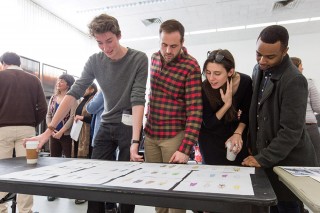Title

Fourth-years John Kroft, Forrest Malloy, Marianne Rendon, and Jimmie "JJ" Jeter look at costume sketches.
(Photo by Richard Termine) More Photos »Each spring, the Drama Division presents the fourth-year repertory cycle—productions of three alternating plays, this year from February 10 to 21. The challenges for the Production Department are manifold. How do you create a set that accommodates three very different plays in the same physical space?
Body
On the morning of January 4, the slightly bleary-eyed (just back from break) but excited fourth-year rep crew assembled. There were approximately 50 actors, directors, stagehands, costume, set, and lighting designers—everyone who'll have anything to do with the plays. And they were there to find out what sort of magic would be created to tie these three together while letting each stand on its own. This year's plays are Athol Fugard's A Lesson From Aloes, directed by Saheem Ali; Jen Silverman's (Playwrights '15) Still, directed by Margot Bordelon; and John Guare's Landscape of the Body, directed by Evan Cabnet.
Following introductions, associate scenic designer Scott Tedmon-Jones read a statement by scenic designer Narelle Sissons, who couldn't attend. An excerpt follows.
“While dreaming up the set design for the rep, we first look for common threads in the plays. This helps us locate the design, and then we look for ways to change the space, responding to the individual needs of the productions. This year we came up with the idea of a perimeter wall and individual islands in the design for A Lesson From Aloes, isolation and abandonment in Still, and a sense of decay and transient life in 1970s New York City for Landscape of the Body. The common thread in our design is the presence of a wall and the sense of isolation in all three productions. These themes are embodied by the clipping wall that represents segregation in Aloes, the ghostly abandoned basement or hotel wall in Still, and the threatening graffiti wall where life and objects have been left behind in Landscape.
“The space and set design have the ability to create change. With the addition of a few pieces, we have attempted to completely alter the look from one play to the next and feel that we have come up with a unique and complex design for each production with our wonderful producers and directors while combining everything into one rep.”









